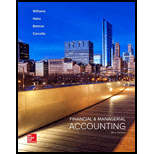
Financial & Managerial Accounting
18th Edition
ISBN: 9781259692406
Author: Jan Williams, Susan Haka, Mark S Bettner, Joseph V Carcello
Publisher: McGraw-Hill Education
expand_more
expand_more
format_list_bulleted
Concept explainers
Question
Chapter 17, Problem 6BP
a.
To determine
Assign the purchasing department’s costs to the individual cost pools.
b.
To determine
Allocate the preproduction pool to the individual product lines.
c.
To determine
Allocate the inspection cost pool to the individual product lines.
d.
To determine
Suggest the manner in which Company N might reduce the
Expert Solution & Answer
Want to see the full answer?
Check out a sample textbook solution
Students have asked these similar questions
Can you solve this general accounting problem using accurate calculation methods?
None
Please provide the answer to this general accounting question using the right approach.
Chapter 17 Solutions
Financial & Managerial Accounting
Ch. 17 - Prob. 1STQCh. 17 - 2. When job costing is in use, underapplied...Ch. 17 - 3. Which of the following businesses would most...Ch. 17 - Prob. 4STQCh. 17 - 5. Which of the following are true regarding...Ch. 17 - 6. Which of the following would be the most...Ch. 17 - 7. Using ABC to allocate manufacturing overhead...Ch. 17 - 1. What is a cost accounting system?
Ch. 17 - 2. What are the major objectives of a cost...Ch. 17 - 3. What factors should be taken into account in...
Ch. 17 - 4. What is meant by the term overhead application...Ch. 17 - 5. What is meant by the term overhead cost driver?...Ch. 17 - Prob. 6DQCh. 17 - Prob. 7DQCh. 17 - 8. Taylor & Malone is a law firm. Would the...Ch. 17 - 9. Define the term activity base.
Ch. 17 - 10. Define the term cost driver.
Ch. 17 - 11. Why is the use of a single activity base...Ch. 17 - 12. Describe how activity-based costing can...Ch. 17 - Prob. 13DQCh. 17 - 14. Why is the use of direct labor hours as an...Ch. 17 - 15. Discuss the potential benefits associated with...Ch. 17 - BRIEF EXERCISE 17.1
Accounting for Overhead
Taylor...Ch. 17 - BRIEF EXERCISE 17.2
Transferring Costs in a Job...Ch. 17 - BRIEF EXERCISE 17.3
Overhead Application...Ch. 17 - BRIEF EXERCISE 17.4
Actual Overhead versus Applied...Ch. 17 - BRIEF EXERCISE 17.5
Types of Cost Accounting...Ch. 17 - BRIEF EXERCISE 17.6
Applying Direct Labor...Ch. 17 - BRIEF EXERCISE 17.7
Applying Direct Materials...Ch. 17 - Prob. 8BECh. 17 - BRIEF EXERCISE 17.9
Selecting Activity...Ch. 17 - Prob. 10BECh. 17 - EXERCISE 17.1
Accounting Terminology
Listed are...Ch. 17 - EXERCISE 17.2
Flow of Costs in Job Order...Ch. 17 - EXERCISE 17.3
Journal Entries in Job Order...Ch. 17 - EXERCISE 17.4
Overhead Cost Drivers; Determination...Ch. 17 - EXERCISE 17.5
Cost Classifications
Identify...Ch. 17 - Prob. 6ECh. 17 - EXERCISE 17.7
Journal Entries, Cost Flows, and...Ch. 17 - EXERCISE 17.8
Journal Entries, Cost Flows, and...Ch. 17 - EXERCISE 17.9
Journal Entries, Cost Flows, and...Ch. 17 - Prob. 10ECh. 17 - EXERCISE 17.11
Solving for Missing Amounts in a...Ch. 17 - EXERCISE 17.12
Solving for Missing Amounts in a...Ch. 17 - EXERCISE 17.13
Determining Balance Sheet Amounts...Ch. 17 - EXERCISE 17.14
Allocating Activity Cost...Ch. 17 - EXERCISE 17.15
Using ABC to Determine a Bid...Ch. 17 - PROBLEM 17.1A
Job Order Costing:
Computations and...Ch. 17 - PROBLEM 17.2A
Job Order Costing: Journal Entries...Ch. 17 - PROBLEM 17.3A
Job Order Costing: A Comprehensive...Ch. 17 - Prob. 4APCh. 17 - PROBLEM 17.5A
Poor Drivers Are Cost Drivers
Ye...Ch. 17 - PROBLEM 17.6A
Applying Overhead Costs Using...Ch. 17 - Prob. 7APCh. 17 - PROBLEM 17.8A
ABC versus Use of a Single Activity...Ch. 17 - PROBLEM 17.1B
Job Order Costing:
Computations and...Ch. 17 - PROBLEM 17.2B
Job Order Costing: Journal Entries...Ch. 17 - PROBLEM 17.3B
Job Order Costing: A Comprehensive...Ch. 17 - Prob. 4BPCh. 17 - PROBLEM 17.5B
Drivers for Drivers
Big Boomers...Ch. 17 - PROBLEM 17.6B
Applying Overhead Costs Using...Ch. 17 - Prob. 7BPCh. 17 - PROBLEM 17.8B
ABC versus Use of a Single Activity...Ch. 17 - CASE 17.1
Classic Cabinets has one factory in...Ch. 17 - CASE 17.2
Implementing ABC
Dave Miller is the...Ch. 17 - CASE 17.3
The Bidding Wars
Kendahl Plastics...
Knowledge Booster
Learn more about
Need a deep-dive on the concept behind this application? Look no further. Learn more about this topic, accounting and related others by exploring similar questions and additional content below.Similar questions
arrow_back_ios
SEE MORE QUESTIONS
arrow_forward_ios
Recommended textbooks for you

 AccountingAccountingISBN:9781337272094Author:WARREN, Carl S., Reeve, James M., Duchac, Jonathan E.Publisher:Cengage Learning,
AccountingAccountingISBN:9781337272094Author:WARREN, Carl S., Reeve, James M., Duchac, Jonathan E.Publisher:Cengage Learning, Accounting Information SystemsAccountingISBN:9781337619202Author:Hall, James A.Publisher:Cengage Learning,
Accounting Information SystemsAccountingISBN:9781337619202Author:Hall, James A.Publisher:Cengage Learning, Horngren's Cost Accounting: A Managerial Emphasis...AccountingISBN:9780134475585Author:Srikant M. Datar, Madhav V. RajanPublisher:PEARSON
Horngren's Cost Accounting: A Managerial Emphasis...AccountingISBN:9780134475585Author:Srikant M. Datar, Madhav V. RajanPublisher:PEARSON Intermediate AccountingAccountingISBN:9781259722660Author:J. David Spiceland, Mark W. Nelson, Wayne M ThomasPublisher:McGraw-Hill Education
Intermediate AccountingAccountingISBN:9781259722660Author:J. David Spiceland, Mark W. Nelson, Wayne M ThomasPublisher:McGraw-Hill Education Financial and Managerial AccountingAccountingISBN:9781259726705Author:John J Wild, Ken W. Shaw, Barbara Chiappetta Fundamental Accounting PrinciplesPublisher:McGraw-Hill Education
Financial and Managerial AccountingAccountingISBN:9781259726705Author:John J Wild, Ken W. Shaw, Barbara Chiappetta Fundamental Accounting PrinciplesPublisher:McGraw-Hill Education


Accounting
Accounting
ISBN:9781337272094
Author:WARREN, Carl S., Reeve, James M., Duchac, Jonathan E.
Publisher:Cengage Learning,

Accounting Information Systems
Accounting
ISBN:9781337619202
Author:Hall, James A.
Publisher:Cengage Learning,

Horngren's Cost Accounting: A Managerial Emphasis...
Accounting
ISBN:9780134475585
Author:Srikant M. Datar, Madhav V. Rajan
Publisher:PEARSON

Intermediate Accounting
Accounting
ISBN:9781259722660
Author:J. David Spiceland, Mark W. Nelson, Wayne M Thomas
Publisher:McGraw-Hill Education

Financial and Managerial Accounting
Accounting
ISBN:9781259726705
Author:John J Wild, Ken W. Shaw, Barbara Chiappetta Fundamental Accounting Principles
Publisher:McGraw-Hill Education
Cost Accounting - Definition, Purpose, Types, How it Works?; Author: WallStreetMojo;https://www.youtube.com/watch?v=AwrwUf8vYEY;License: Standard YouTube License, CC-BY